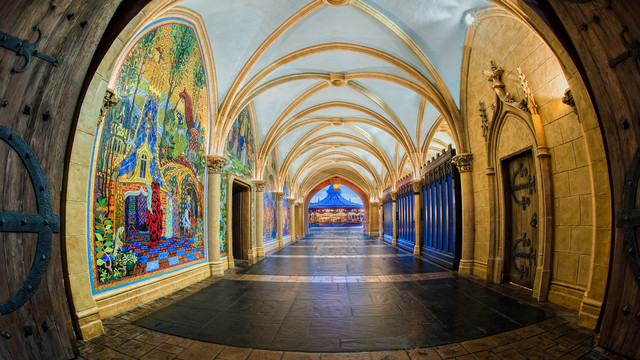Welcome back to Fridays with Jim Korkis! Jim, the dean of Disney historians and author of Jim’s Gems in The easy Guide, writes about Walt Disney World history every Friday on yourfirstvisit.net.
CINDERELLA CASTLE MURAL
By Jim Korkis
Five exquisite richly hued glass mosaic murals adorn the interior breezeway of Cinderella Castle. Each mural is in a Gothic archway fifteen feet high and ten feet wide.
The murals were designed by Disney artist Dorothea Redmond at WED Enterprises in California to tell the highlights of the story of Cinderella as adapted in the classic 1950 Disney animated feature film.
The transformation into a physical reality was given to world famed mosaicist Hanns-Joachim Scharff and his wife along with his daughter-in-law Monika.
Scharff studied art history at the University of Leipzig and was inspired and drawn to mosaics as a youth during a visit to Italy. He was an interrogator for the Nazis during World War II.
The Cinderella mural was actually Scharff’s second assignment for the Disney Company.
In 1966 for New Orleans Square in Disneyland, Scharff did thirty table tops in the Creole Café, the mosaic thresholds for the French Market, and work on two of the quaint specialty shops. The threshold designs were based on original art work from mid-19th century New Orleans.
Later, he and his daughter-in-law would do the mosaic entrance outside The Land pavilion at Epcot.
For the Cinderella murals, Scharff had Redmond’s drawings enlarged to full scale, divided into sections and then covered with fabric netting. With the help of his family, Scharff hand cut and shaped each piece of glass.
Hundreds of thousands of pieces of glass, both the smooth-faced Venetian glass and the rough-surfaced pieces broken from the Smalti (the Italian word for “glass cake”) traditionally used by Italian craftsmen were used. It eventually totaled over a million individual pieces and more than five hundred different colors.
Some pieces were as small as the head of a tack and those that were hand cut were shaped with a power grindstone to get the perfect fit. Bits of gold, silver and numerous “jewels” were also incorporated.
Using the patterns visible beneath the netting, the mosaic pieces were carefully glued by hand, one-by-one, face down onto the fabric which would later be easily removed once the panels were put in place.
Each section was transported to Florida and a crew of six craftsmen pressed the tiles firmly into the wet cement that had been applied to the walls. After the cement had dried and the fabric netting was removed, a coating of mortar was applied and worked into the gaps between the tiles to guarantee the artwork would not only stay in place but endured the constant touching of millions of guests.
From initial design to installation, it took over eighteen months.
There are five murals starting at the entrance. The first mural shows Lady Tremaine reading the invitation to the upcoming ball to her spoiled daughters Drizella and Anatasia. Poor Cinderella is sweeping the floor.
The main section of the second mural is above the doorway but a narrow portion of the mural also trails down on either side of the doorway. The scene depicts the Fairy Godmother magically creating a beautiful gown on Cinderella while the famous carriage is off to the right.
The third mural has Cinderella dashing away from the ball up a flight of stairs and leaving a glass slipper behind with her prince in pursuit.
The fourth mural is the scene where a seated Cinderella tries on the slipper. Standing behind her, Anatasia’s face is red with rage and Drizella’s face is green with envy. The footman with the slipper has the face of Herb Ryman, the Imagineer who designed the castle and the other royal courtier who is standing has the face of Imagineer John Hench.
The final mural shows Prince Charming carrying Cinderella aboard his white horse to live happily ever after.
* * * * *
Thanks, Jim! And come back next Friday for more from Jim Korkis!
In the meantime, check out his books, including Secret Stories of Walt Disney World: Things You Never You Never Knew, which reprints much material first written for this site, and The Vault of Walt: Volume 4, and his contributions to The easy Guide to Your Walt Disney World Visit, all published by Theme Park Press.
Follow yourfirstvisit.net on Facebook or Google+ or Twitter or Pinterest!!



